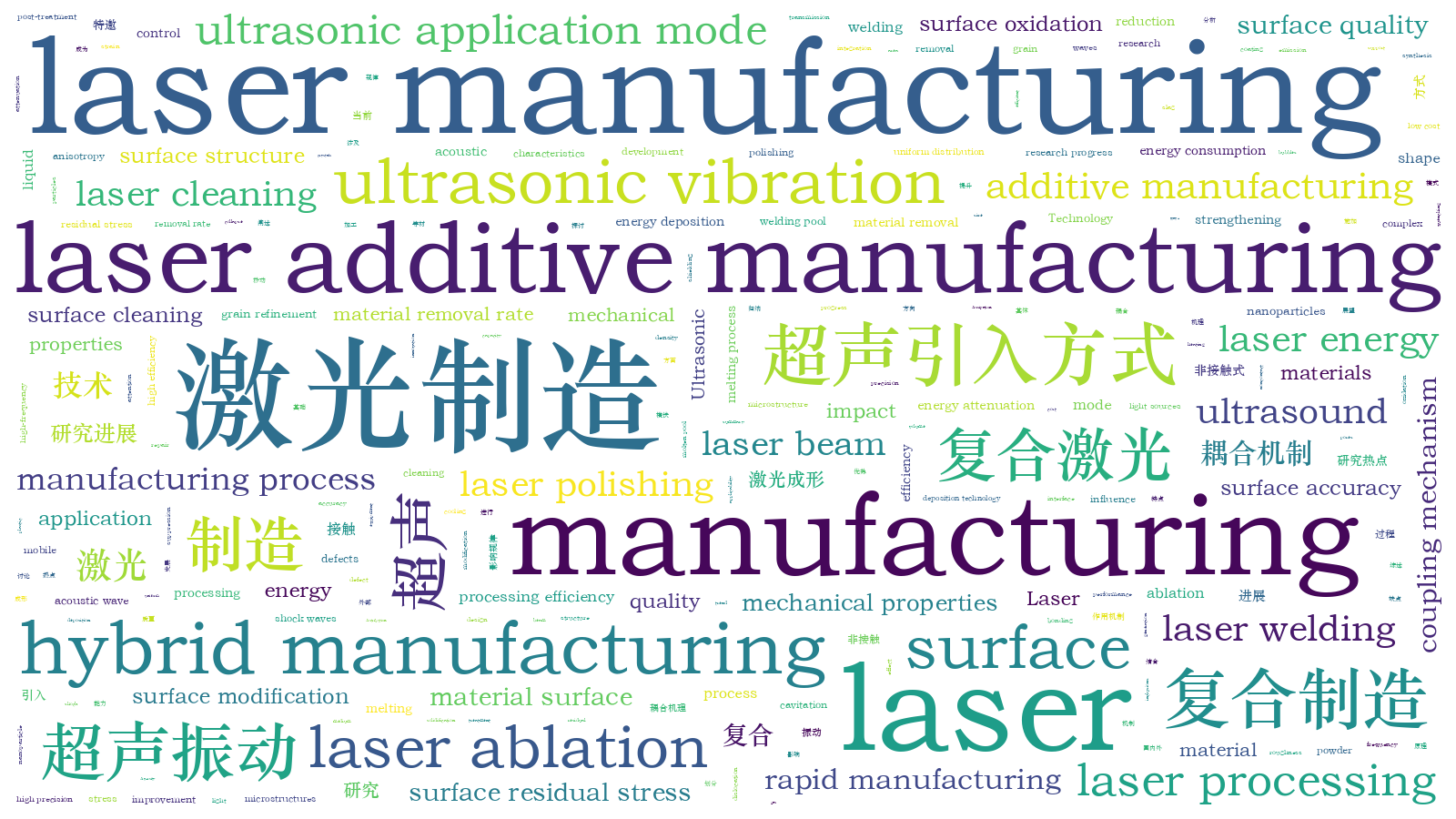超声复合激光制造技术研究进展(特邀)特邀综述【增强内容出版】
Laser manufacturing technology is an efficient manufacturing approach with high precision, high efficiency, low energy consumption, and low cost. The sustained and rapid development of laser manufacturing technology has provided significant opportunities for the industry. To improve the manufacturing quality, laser hybrid manufacturing technology has received significant attention. Among these, ultrasound-assisted laser manufacturing has gradually become a research hotspot worldwide.
The ultrasonic energy field has both volume and surface effects, and can achieve stress superposition, shock waves, and acoustic softening in solid materials to optimize and control their mechanical properties. Ultrasonic vibration can also affect the molten pool flow and solidification behavior of semisolid/liquid materials through cavitation and flow effects and promote a uniform distribution of elements and grain refinement. The mechanical effect of ultrasound promotes the slag emission and reduces the shielding of the laser beam, leading to improvement the quality and efficiency of laser ablation. Therefore, ultrasonic vibrations play a significant role in laser manufacturing processes.
Among various hybrid processes, three different ultrasonic application modes were adopted: fixed-contact, mobile-contact, and non-contact modes (Fig.1). Applying ultrasonic vibration in fixed-contact mode leads to continuous and stable transmission of ultrasound with less energy dissipation but has significant limitations on workpiece shape and size. In the mobile-contact mode, the acoustic energy can be transmitted well at the interface and is less shape-restricted; however, there may be a disconnected contact phenomenon between the ultrasonic head and the workpiece. In the noncontact mode, the process is completely unaffected by the workpiece shape; however, there is significant energy attenuation when the acoustic wave is transmitted in a gas or liquid medium.
In this study, the mechanisms and effects of ultrasonic vibration on laser processing are reviewed based on a summary of the latest research progress. Ultrasonic-assisted laser manufacturing technology with various ultrasonic application modes was comprehensively discussed for laser additive manufacturing, laser formative manufacturing, and laser subtractive manufacturing. The principles and technical characteristics of each hybrid manufacturing technology are discussed, and the influence of ultrasonic vibration on the laser manufacturing process is summarized (Table 1).
In laser additive manufacturing, laser energy deposition technology, synchronously assisted by ultrasonic vibration, is widely used for surface modification, additive repair, and coating preparation. The application of ultrasound inhibits the generation of columnar crystals, resulting in a reduction in the microstructural anisotropy, pores, inclusions, and microcracks. In addition, laser powder bed melting synchronously assisted by ultrasonic vibration has been used in the rapid manufacturing of complex components. The influence of ultrasound on the melting process improved the comprehensive mechanical properties of the parts and reduced the anisotropy in laser powder bed melting. Laser additive manufacturing combined with ultrasonic impact peening can improve the properties of additive manufactured parts by conducting a post-treatment of the ultrasonic impact on the surface of the parts after laser additive manufacturing. The combined effects of grain refinement strengthening and dislocation strengthening result in deep strengthening, defect suppression, and shape and performance control.
For laser formative manufacturing, ultrasonic-assisted laser welding inhibits the defects caused by sudden heating and cooling by applying ultrasonic vibration to the welding pool and then regulates the welding microstructures to achieve high-quality welding. Laser impact combined with ultrasonic impact peening triggers a high-frequency impact on the surface of a material, which has the advantages of both ultrasonic and laser impacts. The microstructure and surface residual stress can be effectively regulated, and the surface accuracy and mechanical properties of the metallic materials can be improved. Laser quenching with ultrasonic impact can significantly improve the mechanical properties of the reinforced layer owing to the multicycle characteristics and excellent control ability of the surface structure and strain state.
In laser subtractive manufacturing, ultrasound increases the plastic flow capacity of a material in ultrasonic-assisted laser ablation technology. The surface melt discharge and surface evaporation of the material are considerably promoted, resulting in an improvement in the surface quality of the removal area and the quality of the hole. In ultrasound-assisted laser ablation for nanoparticle preparation, the ultrasound in the liquid causes cavitation bubbles to form and collapse repeatedly. Additional ablation of the nanoparticles induced by ultrasound enhances the density of the nanoparticles in the liquid and improves the synthesis rate. In ultrasound-assisted laser polishing technology, ultrasound can reduce the bonding tendency between particles and the material surface, leading to a reduction in surface oxidation, an increase in the material removal rate, and a reduction in surface polishing roughness. In ultrasonic-assisted laser cleaning, ultrasonic vibration not only makes the surface easier to clean, but also suppresses the defects induced by high temperatures, significantly improving the processing efficiency and surface cleaning quality.
Ultrasonic-assisted laser manufacturing has gradually become a popular approach for fabricating various structures. A developmental trend in the ultrasonic-assisted laser manufacturing technology is expected. Further fundamental studies on hybrid mechanisms will be conducted to understand complex hybrid manufacturing processes. Broadening the diversity of materials and process applicability will expand their application areas. An innovative design for the ultrasonic application mode and equipment will be developed to improve the integration. In addition, creative laser manufacturing technologies can generate new hybrid manufacturing processes through the development of new light sources, thereby providing significant support for manufacturing innovation and application expansion.
姚喆赫, 潘成颢, 迟一鸣, 陈健, 王发博, 张群莉, 姚建华. 超声复合激光制造技术研究进展(特邀)[J]. 中国激光, 2024, 51(4): 0402103. Zhehe Yao, Chenghao Pan, Yiming Chi, Jian Chen, Fabo Wang, Qunli Zhang, Jianhua Yao. Research Progress of Ultrasonic Assisted Laser Manufacturing Technology (Invited)[J]. Chinese Journal of Lasers, 2024, 51(4): 0402103.







